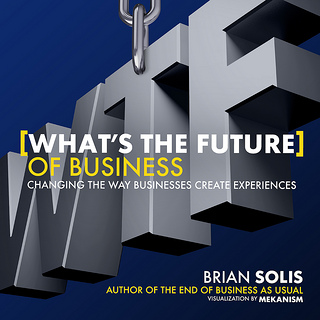 Have you ever wondered what the future of business will look like? Maybe you figured it’s going to be something like business in the past: buy stuff, sell stuff, try to make a profit by selling stuff for more than it cost you to make it, building a better mousetrap, winning friends and influencing people, crossing the chasm, riding the long tail to the tipping point with the other outliers, going from good to great, and dealing with cheese that keeps moving around.
Have you ever wondered what the future of business will look like? Maybe you figured it’s going to be something like business in the past: buy stuff, sell stuff, try to make a profit by selling stuff for more than it cost you to make it, building a better mousetrap, winning friends and influencing people, crossing the chasm, riding the long tail to the tipping point with the other outliers, going from good to great, and dealing with cheese that keeps moving around.The future of business won't be like that. The future of business is all about dazzling people with amazing customer experiences, says Brian Solis, whose new book, What’s the Future of Business? Changing the Way Businesses Create Experiences, has a cover with the letters “WTF†in huge block letters -- a hint, perhaps, that this is not going to be some ordinary business book, but rather a radical manifesto about change, innovation, and disruption. It's business with a dash of irreverence and punk rock thrown in, a little sneer that says, Look, people, the world has changed, there's this thing called social media, have you heard of it?Â
In this new world, the marketing of products becomes as important as the products themselves. Marketers are the ones who create experiences. Which means suddenly marketers stand at center stage, instead of off in the wings. Suddenly all eyes are on you. Are you ready for your close-up? Read this book and you will be.
The Influencers' Influencer Who is this Brian Solis? Folks at HubSpot know him as a pal who will be speaking at our INBOUND conference this August alongside Arianna Huffington, Seth Godin, and Nate Silver. But according to the book jacket, Solis is “globally recognized as one of the most prominent thought leaders in new media,†as well as a “digital analyst, sociologist, and futurist.â€Â He's an influencer's influencer, whose blog, BrianSolis.com, is considered a must-read for marketers. Solis is a rare web intellectual, a guy who can melt your brain on Twitter but can also think and write convincingly in chunks of more than 140 characters. At INBOUND, Brian will talk about how the pace of innovation has sped up and impacted the pace of change within business overall, and probably expand upon the ideas presented in his book.
His Bold Ideas But what is the book about? It has one big takeaway. Companies are on a journey of transformation. We’re living in an age of digital Darwinism where you must innovate or die, all because consumers are more empowered than ever with the internet at their disposal.
And in this new age, Solis argues that we shouldn't segment these consumers by age -- Generation X, Generation Y, Generation Z, Boomers, and Matures. Instead, we should use “Generation C,†in which the C stands for Connected. Generation C serves as umbrella to describe consumers who are active on the internet and social media, regardless of age. “Gen C is not an age group -- it is a way of life,†he proclaims.
In this worldview, the binary is between those who are Connected and those who are Not Connected. The chief distinction is that, “To Gen C, experience is everything. What they feel about your products and services now and over time is shared through these connected networks.†The challenge for brands is to design the experience that those people will have, and “design the journey that they will embark on.â€
Too many companies are using social media but still not really talking to customers -- and that’s partly why they fail to deliver a complete experience, Solis asserts. Presumably these companies deserve points for trying, and it's nice that they've hired someone to run their Twitter feed, but they’re not making the most of the medium. To paraphrase the late great Steve Jobs: You’re doing it wrong. Solis shows you how to do it right.
What’s the Future of Business: Changing the Way Businesses Create Experiences is an ambitious and ultimately optimistic look at the challenges companies face as they adapt to a digital world, a world where empowered and ever more demanding consumers bring to each transaction a new set of expectations. It’s not just a how-to book, though plenty of advice is offered. Rather it is a call to arms, a call to action, a wake-up call to brands in every industry, a book that will help anyone in marketing do a better job of surfing the storm of change that surrounds us. A must read.
Also, don’t forget to come see Brian Solis speak at the INBOUND conference Aug. 19–22 in good old Boston.
DealerNet Services
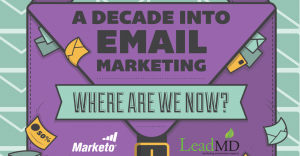 Are you getting the results you want from your email marketing campaigns? Email marketing has been around for a while now, and there’s a reason it’s such a popular channel in most marketers’ toolboxes. Savvy interactions can deepen customer relationships, inspire new ones, nurture and convert leads, and strengthen brand awareness. By delivering compelling messages tailored to specific customer triggers, marketers can take leads from engagement to purchase.
Are you getting the results you want from your email marketing campaigns? Email marketing has been around for a while now, and there’s a reason it’s such a popular channel in most marketers’ toolboxes. Savvy interactions can deepen customer relationships, inspire new ones, nurture and convert leads, and strengthen brand awareness. By delivering compelling messages tailored to specific customer triggers, marketers can take leads from engagement to purchase.
That said, not every marketer is getting the maximum results possible from their email marketing initiatives. In fact, some are completely missing the boat. To learn more about how to maximize your email marketing initiatives, be sure to download our new ebook, A Decade into Email Marketing: Where Are We Now?
The Evolution of Email Marketing
It’s true that we’ve come a long way from the early days of blast campaigns that usually hit the wrong customers, ended up in the spam filter, or simply created feelings of annoyance and intrusion. In fact, the time has never been better to be a marketer. Technologies like marketing automation allow companies to design polished messages that deliver the most relevant conversations to the right prospect at the perfect time. Lets face it, email has always been a cheap medium as well, with no printing and shipping costs to worry about, email helps mid-market and emerging businesses compete with the big leagues. Consider the cost of executing a digital campaign these days vs. the postage driven campaigns of just a few decades ago and you can see how powerful email is not only in terms of engagement but also as a cost cutting measure.
These days we use email for all kinds of initiatives. Whether we want to reenergize fading leads, deepen engagement with existing customers or launch irresistible upsell and cross-sell offers, we’ve got the tools to tailor our messaging with unprecedented precision. And as mobile rises in popularity with countless users, leads are more connected to their email than ever before.
Creating a Seamless Cross-Channel Experience
So what’s the problem? The truth is that there are so many strategies and channels to consider that many marketers feel overwhelmed. Some are uncertain of which tactics they should be using; some are pursuing unproductive initiatives; some are jumping from strategy to strategy without sticking to one long enough to see results. Still others are applying one overarching plan across all channels, without considering the specific parameters for social and mobile campaigns or the role of smartphones and tablets. To create a seamless cross-channel user experience, email strategies must align with the appropriate platforms.
Authenticity Through Relevance
The rapid evolution of marketing technologies has left many marketers with a skill gap, and others completely in the dust. Even businesses that have invested in good marketing platforms often lack the training to fully understand how segmentation, testing and analytic tools can help them drive ROI and measure campaign performance. Another common issue: the failure to understand the necessity of tailored and engaging content. The days of predictable promotional emails are over, and marketers must create relevant emails that foster an authentic connection with customers. Not only can such relevance make the difference between a delete and a transaction, but techniques such as initiating transactional emails or driving readers to dynamic landing pages on marketing platforms can boost conversions, revenue and brand visibility.
So let me ask you again: are you getting the most you can out of your email marketing campaigns? Are you using the right strategies for the right channels? To help you decide – and learn some new tricks – we’ve put together a new ebook, A Decade into Email Marketing: Where are We Now?, which focuses on deft marketing strategies to help you maximize the potential of this rich marketing tool. We’ll share the 5 pathways to high-impact campaigns that attract, convert and close. Take a look and discover how you can design emails that turn leads into customers and engagement into sales.
Want to learn even more about email marketing? Be sure to pre-register for Marketo’s upcoming Definitive Guide to Engaging Email Marketing available on August 7th!
Author: Justin Gray
DealerNet Services
Â
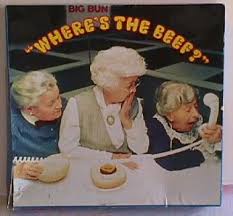 There have been a lot of postings and discussions over how best to improve a Sales Organizations performance. I personally have written many of them.
There have been a lot of postings and discussions over how best to improve a Sales Organizations performance. I personally have written many of them.One thing that they all have in common is the need to have the right people in the right positions and the need for Leadership.
It all starts with Leadership because a true leader will posses all the qualities needed to do the things necessary to make a business successful. Because a true leader is always striving to hit that next level of success and surrounds himself with other leaders who have the same goals.
True leaders are the people who can leave the emotion out of the equation. All emotion stems from insecurity and has no place in running a business or in life in general for that matter. Insecurity gets in the way of truly clear thinking and objectiveness that is the benchmark of a true Leader.
And this is where we hit the first wall to climb because in my career I have not met many totally secure people who fit the true definition of a leader.
You can have all the systems in place that are designed for success but if you don’t have true leaders it won’t matter how well the system is designed it will not function properly.
One big reason that Businesses today lack the leadership needed to build a truly successful business is the lack of compensation. This for some reason lately has become a dirty word in some circles.
All this touchy feely talk about remembering someone’s birthday, giving extra time of and pats on the back in lieu of compensation is just placating the powers that be. Anyone who talks like this is either doing it so as not to upset clients or have never been in the trenches in commission sales trying to make a living-or both.
All this is good stuff but if it isn’t backed up with proper pay for performance you will never attracted the true Leaders that can get the job done.
And other members of these circles are comprised Darryl, Darryl and Darryl (For those of you who remember) who are quarterly driven publicly owned companies that will do anything for a buck for Top Line and Bottom line growth. Doing more with less for the Bottom line and ethically questionable things to grow the Top Line. We have all seen it.
Unfortunately a lot of private companies have adopted the same kind of practices to their own peril which brings me to to “WHERE’S THE BEEFâ€
You can have all the proven systems in place that you want if you don’t pay for performance the true Leaders will find another home in the same or different Industry. Because the real talent in sales can perform anywhere.
If you think about it and have studied or have been in the Automotive Industry long enough the forerunner of the 4 square, the track system, came along in the late seventies, early eighties.
This system owners thought, would give them the ability to hire any sales clerk off the street at lower compensation and get the same results as the real talent.
This didn’t last very long and I know because I was one of the salespeople who left when they lowered commissions. On top of that, in the early eighties, I was making much more money as a Manager “then†than is being offered today. Add the rise cost of living into that and it gets ridiculous.
Before I went back on my own in 2010 I was making much more as a salesperson than most managers without all the responsibility.
The Commission Sales Industry is a unique Industry in the fact that commissioned sales is one rung below being self-employed. There are a very limited number of truly talented professionals in management or sales who can make it happen consistently.
You give me a group of talented professionals with a pay plan that is going to draw them and I’ll take any system out there and make it seem like the best thing since sliced bread.
I recently wrote an article where I talked about compensation and even offered anyone interested in a "pay for performance" pay plan to e-mail me and I would gladly sent it to them.
I even gave an example of a Dealership who had this pay plan who had the highest front and back end grosses in their region and district and were growing sales.
I received “0†requests.
You can argue all you want about systems and team work but in the end if you don’t get off that diet your on and put the “BEEF†on the menu to attract the real heavyweights you are doomed to high turnover and mediocrity.
Written By Bill Cosgrove
DealerNet Services
Photos Represent 93% Of The Most Engaging Posts On Facebook
Tags:According to the latest data, photos now represent 93% of the top posts on Facebook! That leaves status updates to generate only 3% of the most engaging content while links and videos each generate only 2%. It appears photos have completely taken over. Is it time for Facebook to merge Facebook and Instagram, forming one gigantic Facegram?
Videos used to do well on Facebook, but, since so many videos originate with Google's hated YouTube, which Facebook shuns, it's not surprising that videos, despite their popularity on the web, have faded away into oblivion on the blue giant. These days, posting links to useful webpages and articles on Facebook is also a lonely cause; you are the only one likely to see them. Status updates fare a bit better, but, if you really want your pals to see them, you better bleed your heart out.
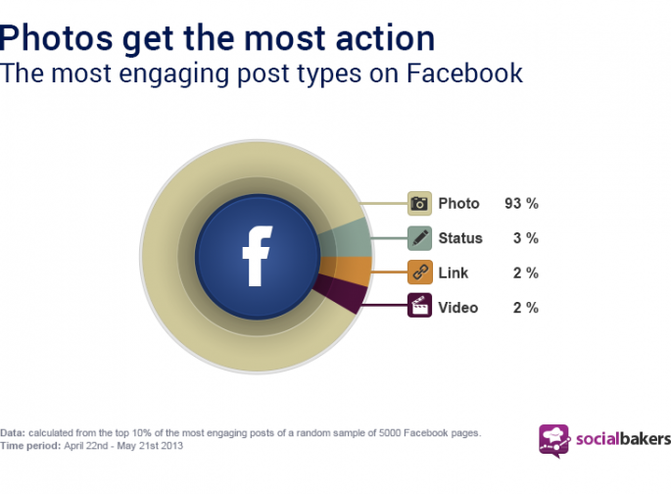
By Daniel Zeevi
DealerNet Services
Why Your Company's Customer Experience May Be Falling Behind
Tags: Regular readers of the Help Scout blog know that we love research and statistics.
Regular readers of the Help Scout blog know that we love research and statistics.I recently came across new consumer data from Forrester, a global research and advisory firm specializing in the customer experience, which features a number of shocking claims.

While many companies think that they are leading the charge with service quality and creating an innovative customer experience, the numbers tell quite a different story … in the eyes of customers, most companies are falling flat.

Today we are going to scrutinize what most companies are doing incorrectly and highlight how to fix these problems.
Avoid reading at your own risk, since we’ll be putting the spotlight on why less than 10 percent of companies are receiving a passing grade from customers!

1. Too Much Imitation, Not Enough Innovation When it comes to delivering an outstanding customer experience, far too many companies are content with simply “keeping up with the Joneses.â€
In the most recent Forrester survey of 100 customer experience professionals, 58 percent of respondents said that their firms drive customer experience innovation by closely watching what their direct competitors are doing, and a full 72 percent look to outright copy companies in other industries.

The embarrassing amount of copying that is going on has been recently pointed out by research analyst Kerry Bodine, and it’s the reason why “good enough†is the disappointingly low bar to which many companies now strive:
Citibank wanted to copy the Apple store so badly that it actually hired the same architects responsible for the Apple store concept to design its bank of the future. Imitation may be the highest form of flattery—but it's not innovation.†There is a lot more risk in copying your competitors than you may think. First of all, they might not know exactly what they are doing; even if they do, it doesn’t mean that what works for them will work for you.

Even worse, many companies are not seeking to imitate the industry leaders, or those businesses most known for their customer experience. According to the Forrester analysis published in the Harvard Business Review:

…13% of companies said that they'll settle for nothing less than having the best customer experience across every industry—in other words, these companies want to be the next Apple, Disney, or Zappos.â€Ã¢Ã‚۬ That leaves a whopping 87 percent of companies who will settle for less than the best when it comes to their customer experience!
We’ve previously shown you the data on how 80 percent of companies believe they are delivering superior service to their competitors. In light of these admissions, it’s easy to see why in reality they are falling flat. Consider this startling statistic from the Forrester survey:

In 2013, only 8% of the companies surveyed received a top grade from their customers for their customer experience.
The problem: Many companies think that they are leading the charge in customer experience innovation, but in reality they are okay with being just “okay.â€Ã¢Ã‚۬
This sort of thinking is dangerous. You’ll never be able to convince customers to switch to your company by simply matching the passable service quality of your competitors.
The image below offers a supporting example (because here at Help Scout, we’re nothing if not honest!) of this fact. Many of our prospective customers who are currently with a competitor stay not because they are blown away by what they are paying for, but because their current experience is “good enough.â€Ã¢Ã‚۬
Since the majority of companies are failing to deliver when it comes to customer expectations, following their lead will likely result in a vicious cycle of the blind leading the blind. Being at the head of the pack means turning your back to them.

2. Using Technology as a Crutch A great customer experience is still reliant on memorable employee-to-customer interactions. In other words, it’s still about the people. (Breaking news: The sun is hot!)

Why, then, do so many companies rely on technology as the crutch for delivering their service?

Keep in mind that technology alone isn’t the culprit here; the issue is using technology without considering the needs of your customers (“technology for technology’s sakeâ€), which can end in disaster.
A multinational auto insurance company provides an excellent example here. The company invested heavily in a new mobile app that would connect customers to a call center agent in an emergency.
The idea looked good on paper, but it failed to account for the fact that drivers wouldn’t preemptively download the app in anticipation of getting into a car crash … and they had more pressing things on their minds than browsing an app store once an accident occurred.
The result: Another so-called innovation that failed to produce business results.

The lesson here is that new ways to improve the customer experience must be founded in differentiation and their ability to generate long-term value for the business.
Simply being innovative or on-trend won’t result in real improvements in doing business with your company.
Remember why this app fell flat, and be sure that the improvements you make are geared toward resolving the issues that actually plague your customers.
How to Fix These Problems Bodine has outlined a few smart, applicable strategies for putting some of the worries discussed above to bed.

Below are her top three tips for avoiding a stagnant, misguided customer experience.

Tip #1 Rethink Opportunities Before Moving Academic research has shown that when it comes to brainstorming, the best ideas and most creative solutions result from looking at the problem from multiple angles. As Einstein said, “If I had an hour to solve a problem, I’d spend 55 minutes thinking about the problem and five minutes thinking about solutions.â€
Bodine sees the lack of multi-angled investigation as one of the fundamental errors that most business owners make when they seek to improve the customer experience. She highlights this point in her HBR piece:
Companies need to start their innovation initiatives with an outside-in approach that frames their business challenges within the context of customers' unmet needs.†Essentially, Bodine is saying that companies should reframe and closely evaluate what customers actually want before diving headfirst into the latest favored strategy in the world of CRM. This advice seems obvious, but as evidenced in the insurance example above, companies are prone to creating apps and new tools without closely evaluating whether or not they will truly be useful to customers or whether they solve a real pain point.

Bodine continues with an example from Philips Healthcare, who gathered customer feedback by using an innovative real-life form of user testing:

To identify new opportunities, for example, Philips Healthcare mapped out a typical day in the life of a radiologist, a key purchase influencer, regardless of whether those activities involved Philips. This approach enabled the team to identify a key pain point in radiologists' daily work—an inability to compare one patient's scan with those of others—that Philips already had the data for and capability to solve but hadn't considered productizing.â€Ã¢Ã‚۬ Tip #2 Infuse the Experience with the Brand Many of the most memorable customer experience innovations are strongly tied to the brand that first championed them. In many instances, the idea wasn’t so much unique as it was different. Bodine points to some big brands that were able to pull this off:

Ikea Systems' cartoon furniture assembly instructions, Mini Cooper's retro-inspired dashboard, and the cheerful chirp of a Zappos’ customer service rep—the qualities of these customer experiences create strong associations with their brands.â€Ã¢Ã‚۬
When your customer experience is intrinsically tied to your brand, you will naturally avoid the first problem discussed above—innovations, features and experience improvements that don’t suit your customers’ actual needs.

In another fascinating case study, Bodine highlights how a new restaurant concept from Bertucci’s addressed this highly important aspect:
That's why design and innovation consultancy Continuum created mood boards when developing a new restaurant concept for Bertucci's called 2ovens. A collage of carefully chosen photos depicted the desired 2ovens vibe; helped align internal Bertucci's stakeholders; guided the design of touchpoints as diverse as the dining space, menu, and website; and even shaped the company's hiring policies.â€Ã¢Ã‚۬ A 2ovens-style focus on innovation efforts that fit your brand’s personality and way of doing business will also help you create experience-specific elements that your competitors can’t easily mimic.
Tip #3 Create an Experience Around the Business Model Lastly, Bodine encourages companies to innovate in areas that best support their business model of choice. Just as choosing the right channel for customer service is critical (whether you adhere to traditional or newer online service methods), innovations for the customer experience should be based on the business you are running and your business model’s inherent strengths.
As an example, Bodine focuses on how ZipCar was able to spur on innovation where other traditional companies couldn’t compete:

Zipcar's car-sharing business model drove a need for keycard (and then mobile phone) vehicle entry—new types of interactions that traditional rental companies never envisioned.†Where can your company improve the customer experience and overall satisfaction while playing off of the advantages of your industry and how you do business?

 I recently read that today the reality is that, whether prospective buyers are in your virtual showroom or your physical showroom, they’re a buyer. Maybe not today, but statistically the Internet customer is highly likely to buy within 90 days.
I recently read that today the reality is that, whether prospective buyers are in your virtual showroom or your physical showroom, they’re a buyer. Maybe not today, but statistically the Internet customer is highly likely to buy within 90 days.
94% of car buyers begin the process online, according to recent estimates, yet most dealerships attribute less than 30% of actual sales to Internet leads. Why the discrepancy? Most consumers do research online but instead of submitting a lead, they decide to call or walk into a dealership when they’re ready to buy. Because of all the research they can do on their own, though, customers today visit only 1.4 dealerships before purchasing a car, down from 4.5 in 2005, according to J.D. Power.
And, according to a recent study by CAR-Research XRM, only 25% of people leave showrooms because they are “still shopping.†The rest leave because of inventory, financing or some other issue. These customers are ready to buy, the only question is, are they buying from you?
Statistically speaking this means that you have a better than a 50/50 chance of selling 75% of customers that walk through your door. You now have the best odds for conversions than ever before.
So if you don’t have the right sales management, finance management and sales team you are losing sales. Patting people on the back is great and there isn’t anyone that doesn’t appreciate praise but if you want to have the managers and salespeople who are true leaders; that will have the right inventory; Mangers that want to get involved with every customer that drives on your lot and salespeople that know how to deal with customers to get the sale- you need to compensate them. This is the only way you are going to recruit the real talent. In other words you need seasoned people that have a solid track record of consistently exceeding goals and objectives.
Marketing:
As I stated in my blog "Take Back Your Marketing†The technology exists today for dealers to get much better results from their own website. Technology is constantly changing the marketing landscape and dealers today can use smaller more efficient marketing companies that will work for them and cut back on the1000s of dollars they are paying the big classified sites and big marketers (they don’t need anymore) in much more productive ways with much better results.
Once you have built the right sales and marketing team you should have an outside consulting company come in quarterly to audit the performance of the sales and marketing departments who can provide fresh out of the box ideas of new industry developments, potential problem areas that are not being noticed and possible solutions to ongoing problems.
This means that by putting your precious resources to work efficiently in the right areas your ROI will be higher and give you results that will drive more to the bottom line.
Posted By Bill Cosgrove
DealerNet Services
 In the past, writing skills for B2B marketers weren't as important as being able to source lists and batch send a heavilyproduct-oriented email, hoping someone will open the email and maybe even read it!
In the past, writing skills for B2B marketers weren't as important as being able to source lists and batch send a heavilyproduct-oriented email, hoping someone will open the email and maybe even read it!But it's not so easy these days.
Your buyers are sick of interruption-style marketing tactics, so B2B marketers are switching to content marketing tactics in order to cut through the noise and engage successfully with the target audience.
Content marketing entails drawing buyers to you so they happily part with their details in exchange for information they actually value and want - and that rarely involves talking about your product or service.
So you have to develop your writing skills to be a successful B2B marketer in this day and age. Here are some of the different things you will need to be able to write:
1. Website Copy Because you're most familiar with the buyer personas that you're selling to, you will probably be given the task of writing copy for the entire website - and beyond. This is no easy feat.
Write with SEO (Search Engine Optimisation) in mind Although Google is asking for an emphasis on content and user experience, keywords are still important, because it's what your buyers are searching. You must know how to write for:
- On-site SEO. To make sure your website is easily found, you'll have to think of attractive metadata and meta descriptions. You'll also have to decide on phrases for headings, alt text, and internal links. Then there's the job of writing the actual copy.
- Off-site SEO. Besides guest blogs, off-site SEO is all about social media. These include everything from status updates to personal and company bios.
Build Landing Pages & Calls to Action (CTAs) These are really important, because CTAs entice buyers to visit your landing page, and landing pages entice buyers to convert into contacts. For this reason A/B testing would be a good idea on both to test the language and design you have used.
If you're not sure what kind of copy would be most successful, put up variations and see which one does best when you have a good data set. Your marketing automation software should be able to do this easily.
It's also important to consider how you will structure your forms on these pages. While you must add enough fields to make it easy for yourself to segment your contacts later on, if you're too demanding you will scare people away. You want to have contacts to market to in the first place!
Use Paid Ads Using Google AdWords for PPC or remarketing campaigns can work really well - if you're offering the right thing, in the right way. Remember, people are completely sick of being sold to, so don't be too pushy. Consider what stage of they funnel they're in, and match your offer accordingly.
For example, link to a piece of content if they're still educating themselves. But if they're lower down the funnel and already looking for a solution like yours, that's when you link to a demo, trail or product/services page so they can find out more.
2. High Value Content Buyers don't need to talk to a salesperson until they're ready to buy. When they're doing research, they're making those early buying decisions themselves. Use your high value content to be seen as a trusted source of information when they're in that key stage of their journey.
Write Smart Blog Posts I do not mean press releases about your product, or new hire, or what award you have recently won. None of those blogs will be of any value to your buyer. Resist the urge to talk about yourself and give them some valuable tips that will make their lives easier. Prove to them that you know all about the problems they're facing, and you are happy to share some tips on how they can solve these problems.
Which brings us to our next point.
Develop "Chunky" Content Each blog should have a CTA at the end which serves as a way of converting your blog reader into a contact. But again it has to be of high value to them, aligning with your blog topic. Most of the time, it's something like an eBook, a research report, or a webinar. It can be anything, as long as it's worth it to your buyer. Put yourself in your buyers shoes - what are they looking to get out of the blog? Use an offer that best suits that purpose.
Invest In Case Studies The old school case study still has a place in content marketing - as long as it's written with an inbound twist. This means that you focus more on the experience of the person you're interviewing. How did they feel at the time? What pushed them to realise they had a problem? How did they go about their search? Write as if you're telling a story. You are trying to demonstrate to other potential buyers that you understand their world and have solved their problems before. These work particualrly well at the consideration stage, once your target buyer are past the awareness stage of their buying journey.
3. Emails Writing non-salesy emails can be tricky if you've never done it before - especially if you're sending it to people who don't know who you are yet. It's imperative that you have a strong incentive for them to open, read, and click through your email.
The basic structure should go like this:
- Introduce yourself. Answer the question: Who are you?Â
- State your offer. Answer the reason: Why are you emailing me?
- Reinforce your offer. Answer the question: Why should I care?
- Provide instructions. Answer the question: What should I do next?
Here are three awesome blog posts for further reading:
- 4 Steps to Writing B2B Promos That Actually Work (MarketingProfs)
- 11 Smart Tips for Brilliant Writing (CopyBlogger)
- Copywriting: How to improve headlines on landing pages and blog posts (MarketingSherpa)
Dealer Net Services
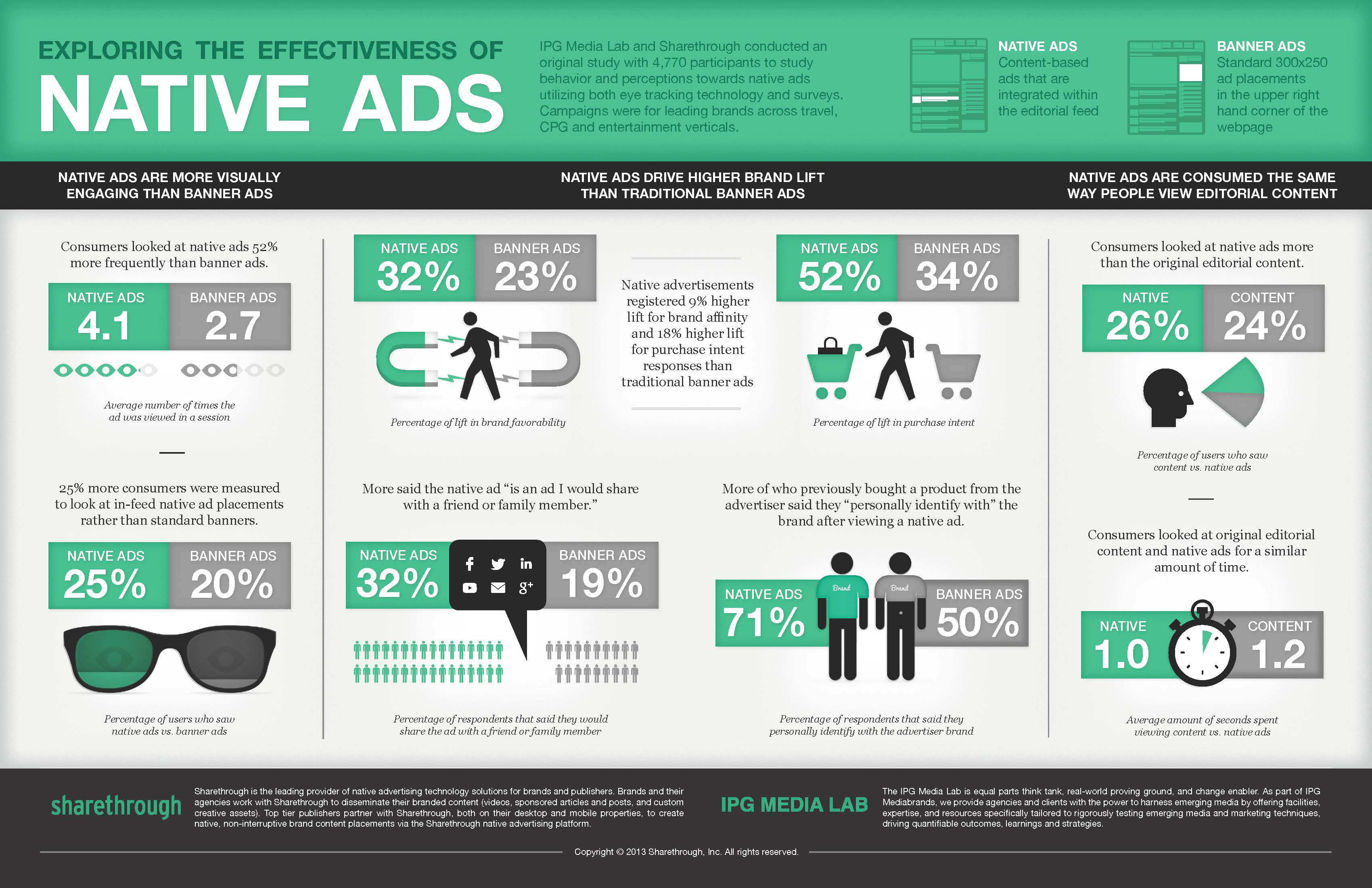
Definitions of native advertising still vary
Native advertising has seen a growing chorus of interest among publishers and ad buyers. Integrating sponsored content into digital channels has opened new doors for marketers to reach distracted consumers and provided publishers with new opportunities to generate ad revenue.
According to a June 2013 survey from the Online Publishers Association (OPA) and Radar Research, while many publishers may still be experimenting with how and what native advertising they will offer, most have already rolled out some native ad opportunities. Nearly three-quarters of polled US publishers said that they already offered native advertising on their site, and another 17% said they were considering offering it this year. Only 10% had no native ad plans of any kind.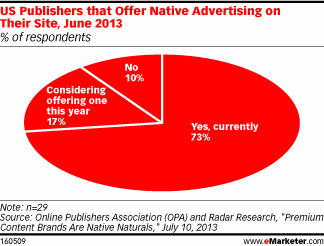
But even as more publishers roll out native advertising, there is still variation in how they think about and begin to define the new ad products. Nearly all publishers attested to the most essential definition of native advertising as “integration into the design of the publisher’s site and [an ad that] lives on the same domain.†And nearly nine out of 10 also said that native advertising was “content produced in conjunction with the advertiser, or by the advertiser, that runs within the editorial stream.†A slightly lesser 79% believed native advertising must be clearly delineated and labeled as such.
These may be crystallizing as the central tenets of native advertising.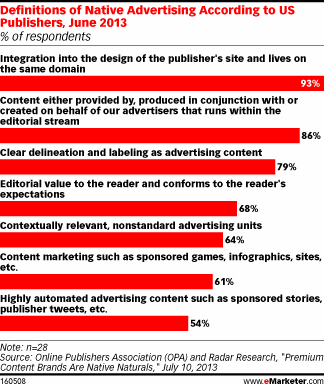
To evaluate their native ad campaigns, publishers said engagement was the leading metric marketers used, cited by 57% of respondents. That was followed by traffic, at 43%. Social sharing came in at one-third of respondents, indicating that while advertisers may want to get consumers sharing their native ad posts, this is not their No. 1 priority.
Market research company BIA/Kelsey estimated in April that this year, US native ad spending on social sites will reach $2.36 billion, or 38.9% of total US paid social ad expenditures. By 2017, social native ad spend will grow to $4.57 billion, and its share of social spending will inch up a few percentage points to 41.7%. But with native advertising reaching into so many digital channels besides social, this is likely far below the total outlays that will go toward native ads in all their different iterations.
eMarketer
DealerNet Services
 By using an omni-channel approach, the Topshop brand has generated a year’s worth of average Facebook activity in just four days. Photograph: Kin Cheung/AP The exponential growth of digital has created an environment that 20 years ago didn't exist, and even today we are still finding our way around it.
By using an omni-channel approach, the Topshop brand has generated a year’s worth of average Facebook activity in just four days. Photograph: Kin Cheung/AP The exponential growth of digital has created an environment that 20 years ago didn't exist, and even today we are still finding our way around it.Young people have grown up in this digital environment and are unafraid to use it. What is clear is that if we want to survive and prosper in this new digital era, we need to look at not only what it can do for our brands, but also what it can't.
And the one thing that online can't reproduce is the physical interaction between your consumer and the product. Offline gives us the opportunity to fulfil other senses that are involved in making a purchase. A physical place is somewhere to return a product, to have a conversation with someone face-to-face. It's a place where an issue can be resolved immediately. Online customer service has a lot to live up to.
In a recent survey, 60% of respondents said that they expected converged retail channels to be the norm by 2014. But more than half of shoppers said that most retailers lack consistency in the way they present themselves across channels.
Your customers will trust someone who is reliable, consistent in what they say, how they say it and what they promise. But more importantly, they expect to have the same brand experience wherever and whenever they interact with your brand.
The future is omni-channel By 2014, nearly everyone in western Europe and the US will have access to a smartphone connected to the internet. The world is already populated by brand-savvy consumers who are now in control. They say where and when they want to shop, and in some cases, what they are prepared to pay for a product. Retailers can't afford to let any moment of their customer brand experience to be less than rewarding, responsive and reliable.
The future is omni-channel: a mix of all the different ways people like to shop, blended together but all saying the same things. This means in store, on the web, through mobile, TV and social media.
Global research expert Forrester has speculated that the future consumer will want not just responsive interactions but adaptive ones, with content delivered in a way that best suits them as individuals, and their particular device.
Digital experiences will need to be more contextual, possibly including location, purchase history and recommendations. Devices will sync together and with other products allowing people to order from one device and check progress of delivery from another. And information visualisation – shortened to "infovis" – will need to be mainstream.
Brands taking the leadAlthough this digital integration is still in its infancy, some brands are already beginning to adopt it, including Burberry, Topshop, Hollister and M&S. Topshop recently launched a campaign where shoppers received a free styling and make-up session and were invited to create a digital 'Wish you were at Topshop' postcard using Instagram.
Once the postcard photo had been taken, they were given a copy to take home and were also able to upload it to Facebook and the Topshop gallery. To date it has generated 640 blog posts, with a reach of 1.4 million, as well as 5.3m views on Facebook and 2,000 comments. That's a year's worth of its usual Facebook activity in just four days. And as a result, it has become the number one fashion retailer on Instagram.
Or take M&S, a stalwart of the high street, yet embracing online and offline integration with Wi-Fi in store. The brand is also investing in connecting mobile web to the in-store experience. M&S sales assistants will carry tablet devices, and touchscreen kiosks are placed throughout stores to engage shoppers and make customer service easier.
If all channels are connected, customers can start their journey on one channel and complete it on another, creating seamless experiences that increase convenience and engagement, and with consistent brand experience.
Written by Max Eaglen
DealerNet Services
 Have you noticed that more and more ads have been creeping into Google’s search results over the last few years? The result is that all the actual search results (known as “organic†results) are being pushed further and further down the page. The Problem In the screenshot below you can see the Google Ads highlighted in the red rectangles. This is what the Google results page looks like if I search for “Brisbane mechanic†on a laptop with a screen resolution of 1280×800, which is fairly common for 14″ or 15″ laptops (different screen resolutions will show more or less of the results page). As you can see, only two organic results show on the page without needing to scroll down. The content that shows at the top of the page without having to scroll down is known as being “above the fold“. In the same space there are SIX ads! Not to mention the ads get pride of place at the top of the screen, encouraging more people to click on them.
Have you noticed that more and more ads have been creeping into Google’s search results over the last few years? The result is that all the actual search results (known as “organic†results) are being pushed further and further down the page. The Problem In the screenshot below you can see the Google Ads highlighted in the red rectangles. This is what the Google results page looks like if I search for “Brisbane mechanic†on a laptop with a screen resolution of 1280×800, which is fairly common for 14″ or 15″ laptops (different screen resolutions will show more or less of the results page). As you can see, only two organic results show on the page without needing to scroll down. The content that shows at the top of the page without having to scroll down is known as being “above the fold“. In the same space there are SIX ads! Not to mention the ads get pride of place at the top of the screen, encouraging more people to click on them.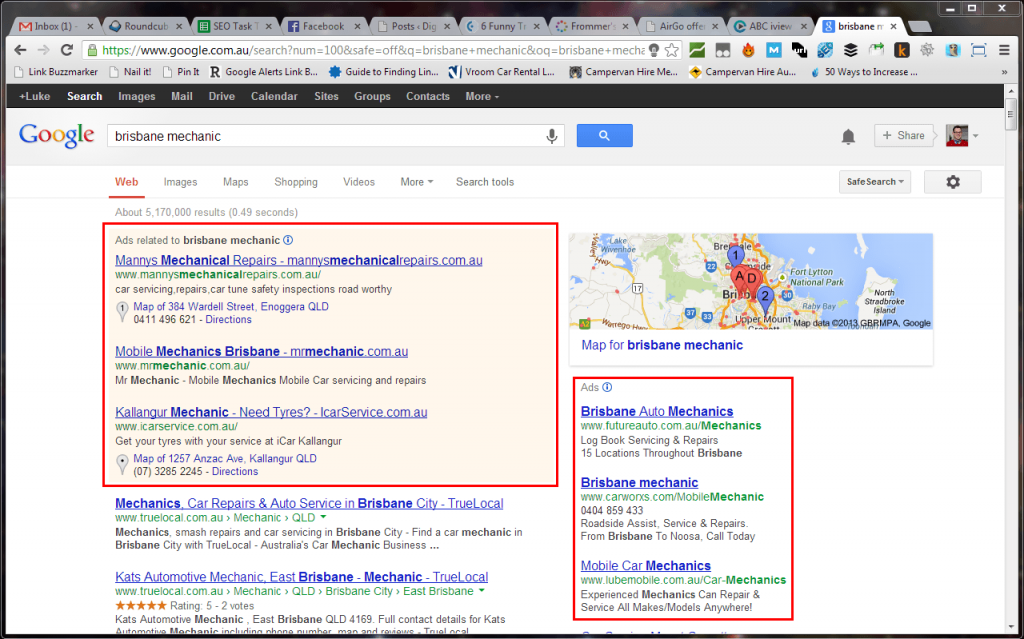
For some results there aren’t ANY organic results above the fold. That means everything you see after you search is advertising!
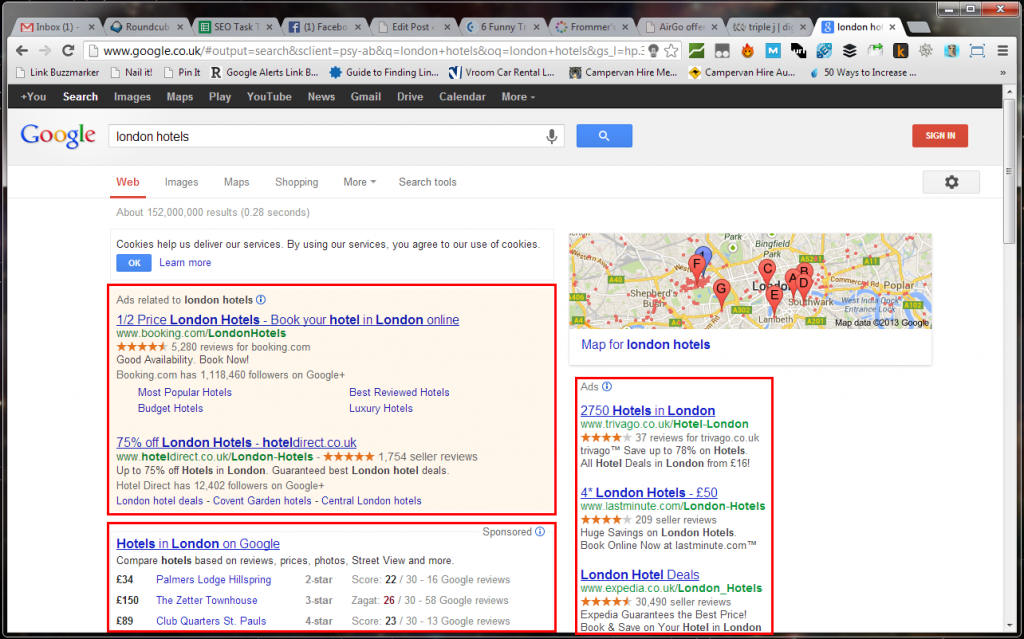
What Else Can I Do? “I want to rank number 1 on Google†is not a valid digital marketing strategy. Even less so now that the actual organic listings are being pushed so far down the page. The good news is there are so many other things that you can be doing to improve traffic to your website other than “traditional†SEO. Here are some ideas to get you started.
- Embrace social media. I don’t mean go and post funny cat photos on Facebook. I also don’t mean to go and buy a bunch of fake Facebook likes on Fiverr. I’m talking about actually being social. This gets right to the heart of what social media is about. Do some research and find out where your target market is active online – is it Facebook? Twitter? Pinterest? TripAdvisor? The answer will vary depending on your industry and the demographics of your target market. Once you know where your target market is, go and be social with them! Think about what that means. Is standing on a soap box yelling about your latest products or services “being social� No! Yet that’s exactly what most companies do on their social media accounts. What you should be doing instead is being helpful, getting involved in conversations and solving people’s problems.
- Become the authority for information or news on your topic. Seek out and write for relevant publications that may reach your target audience. A good way to do this is to look on websites like SourceBottle for journalists and bloggers that are seeking sources for their articles. Get in contact when they’re looking for something that you can help with, and you’ll often end up in a magazine, newspaper or on a website appearing as the expert on a certain topic, with a link to your website.
- One of the best ways to get extra exposure and PR is to network with other people in the industry, and with opinion leaders. Do the groundwork and build up these relationships and it will pay off in the longer term. If you need help with networking, I’d highly suggest reading Never Eat Alone by Keith Ferrazzi.
- Make the most of your existing customers and website traffic by getting them to sign up to regular e-mail newsletters. Once a month or quarter may be enough, depending on your website. Don’t send out updates just for the sake of it. Offer something interesting, insightful, newsworthy and/or funny. This will keep people coming back to your website and keep your brand front-of-mind.
- Find relevant blogs and comment on them. You’re not commenting for the power of the backlinks, but once again to help build your name as an expert and someone helpful. Be sure to use your name (not your company name) as this will make it much easier for people to relate to you, and you’ll come across as much more genuine and approachable.
- Go the extra mile for your customers. Word of mouth always has been (and still is) one of the most powerful forms of advertising you can get. Your customers will become advocates for your company (and website)!
- Branding is super important. Make sure your brand is consistent and easily recalled by customers. A nice clean website design is also important, as bad design can result in visitors clicking the back button straight away. Come up with a great tagline or business name and it will stick in people’s minds much longer. Guess who they’ll think of when they need the product or service that you provide?
by Luke Chapman
DealerNet Services
CALENDAR
CATEGORIES
TAGS
TWITTER POSTS
CALENDAR
- powered by
- One Big Broadcast
- creative by
- WebStager
© 2026 One Big Broadcast | All rights reserved



